We completed our annual trip to Tahoe for 2024 and it was an unusual year. There had been a fair amount of snow over the winter, but it became unseasonally hot early. Almost all the snow had melted out and flowers were blooming early but were short lived. By the time we got there, flowers were found mostly in the higher elevations. We also did a side trip to Mono Lake and visited some of the eastern Sierra Nevada for the first time.
This photo is of Mono Lake South Tufa at sunrise. Mono is pronounced “MOH-noh” (not like the disease). This California lake is east and south of Lake Tahoe and is an ancient saline lake that covers more than 70 square miles and is estimated to be 760,000 years old. These tufa formations are created by calcium rich springs flowing up from the bottom of the lake that react with the carbonates in the lake water forming calcium carbonate limestone. The solids build on itself slowly underwater forming the tufa tower. When the lake level drops, the exposed tufa stops growing. The color of the tufa during the day is a creamy white, but the pink glow of sunrise provides more color to the tufa and the mountains in the background. The Lake has no outlet so the dissolved minerals in the fresh water that flows into the lake are concentrated as the water evaporates. There are no fish due to this high concentration of salts and minerals so only brine shrimp and alkali flies can thrive in the water. The brine shrimp sustain millions of migratory birds that visit the lake each year. .
Another photo of Mono Lake tufa, just a bit after sunrise.
Navy Beach on Mono Lake with geese .
Desert grass with morning dew catching the rays of light at sunrise near Mono Lake
Morning on Silver Lake in the eastern Sierra Nevada. This lake was on the June Lake Loop, a road up into the foothills of the eastern Sierra Nevada that passed by June Lake, Silver Lake and Grant Lake Reservoir. We had a big breakfast at the Silver Lake Lodge after getting up for sunrise on Mono Lake.
Near Mono Lake is the ghost town of Bodie. We did not know about the ghost town, “discovered” it while there and should have planned more time to spend there.
Per the Park website: Bodie State Historic Park is a genuine California gold-mining ghost town. Visitors can walk down the deserted streets of a town that once had around 2,000 structures and a population of roughly 8,000 people.
The town is named for W.S. Body (or Bodey), who discovered small amounts of gold in hills north of Mono Lake. In 1875, a mine cave-in revealed a rich vein of ore, which led to purchase of the mine by the Standard Company in 1877. People flocked to Bodie and transformed it from a town of a few dozen to a boomtown. In 1881, Bodie’s “bust” began and the town’s population declined drastically. The town’s population continued to decline until only a few remained. Mining officially ceased in Bodie in 1942, the final nail in the coffin for Bodie’s township. Two large fires in 1892 and 1932 reduced the town’s remaining structures down to less than 10% of the 2,000 structures that once stood.
Only a small part of the town survives. Interiors remain as they were left and stocked with goods. Designated as a National Historic Site and a State Historic Park in 1962, the remains of Bodie are being preserved in a state of “arrested decay.”
More Bodie artifacts
Karin is enjoying the blooming Sierra Stickeseed (Hackelia nervosa) in Tahoe Meadows. The seed from this flower is about 1/4 inch in diameter, covered with barb-tipped prickles that stick to almost anything, explaining the common name.
Meadow Penstemon (Penstemon rydbrgii var. oreocharis) in Page Meadows on the west side of Lake Tahoe.
We visited Page Meadows on the west side of Lake Tahoe early in the trip and found these small flowers that we thought were Blue Eyed Mary but later identified as Toothed Calicoflower (Downingia cuspidata). Page Meadows were still wet from snow melt and the mosquitos were plentiful but we came prepared with long sleeves, pants, and bug nets over our hats/head. This allowed us to take our time enjoying the flowers and scenery while others had to keep moving (and swatting) mosquitoes).
Karin is enjoying the mass of wild iris: Western Blue Flag (Iris missouriensis) on the Pacific Crest Trail north of Carson Pass. There were many more irises than we had ever seen before. The Western blue flag iris has been used in many ways. For example, its rhizomes were used superficially to treat infections, wounds and ulcers. However, the rhizomes are toxic if ingested. The fiber was also woven into nets and ropes to catch fish, deer, and other game. The mountains in the background are Round Top in the middle and The Sisters on the right.
We always find a “new to us” flower or two while visiting the Tahoe area. This flower is called Old Man Whiskers (Geum triflorum), also called Prairie Smoke. The “fruit/seed” from this flower has pink strands that look like whiskers and when in mass look like a mat of hair (or smoke). Native Americans once boiled the roots to produce a tea that was used medicinally for a variety of purposes, such as wound applications and sore throat treatments.
Pretty Face (Triteleia ixioides) on the Pacific Crest Trail north of Carson Pass
Karin is enjoying all the fresh produce, fruit, and berries at the Farmer Market in Truckee, CA
Randy on the TRT (Tahoe Rim Trail) near Barker Pass surrounded by Mule Ears (Wyethia mollis) with the mountains of Desolation Wilderness in the background.
Karin enjoying the Mule Ears (Wyethia mollis) and Spur Lupine (Lupinus arbustus) north of Barker Pass.
Randy and Karin at Galena Falls (iphone photo) on the TRT. There used to be a mass of Many Leaved Lupine at the base of the falls, but now the willow has covered it all up. Galena Falls/Galena Creek drains toward Reno and does not recharge Lake Tahoe. (Actually, 80% of the water entering Lake Tahoe is from snow falling directly on the lake).
Cousin Carole visited us while in Tahoe and we walked the Tahoe Meadows Intrepritive trail. Next to them is a patch of Many Leaved Lupine (Lupinus polyphyllus) and Gray’s Lovage (Ligusticum grayi), the white bloom flower in the carrot family.
We visited the old mining town of Virginia City and saw this ‘in character” actor poping a whip while the tourists watched.
Karin is taking a rest at Picnic Rock, the vista overlook of Lake Tahoe on the TRT (Tahoe Rim Trail).
This year we found two flowers in Tahoe Meadows we had not seen there before (but had seen elsewhere numberous times): the Mountain Larkspur (Delphinium glaucum) (purple) and the Cow Parsnip (Heracleum lanatum) (white). The Larkspur contains toxins, and no parts of them should ever be eaten. They can be fatally poisonous to both humans and animals. Cow Parsnip is strongly flavored but ebible and is used as an herb; however, it is a paradox: touching the plant can cause skin irritation, and if you get the sap on your skin and have it exposed to sunlight, it will cause photodermatitis, or a nasty rash.
Usually, when we are in Tahoe, the Ranger’s Buttons (Angelica capitellata) are just starting to bloom about the time we are leaving but this year, they were in full bloom in Tahoe Meadows. The flower is in the carrot family and also known as Button Parsley Grayswamp, Swamp White Heads, White Heads, and Woollyhead Parsnip. Even though it is part of the carrot family, it is slightly toxic.
Karin in a patch of California Corn Lilies (Veratrum californicum). It is commonly called “Corn Lily” because it is hard to look at without thinking “Corn”. But it is not related to Corn. And it is not even a Lily. This plant is being studied for its potential medicinal uses in fighting cancer.
There is this one spot along the Tahoe Meadow lower loop trail that the Alpine Lily (Lilium parvum) can often be found.
Randy and Karin in a patch of California Corn Lilies (Veratrum californicum) overlooking Tahoe Meadows. This was one of our last hikes before heading back home.
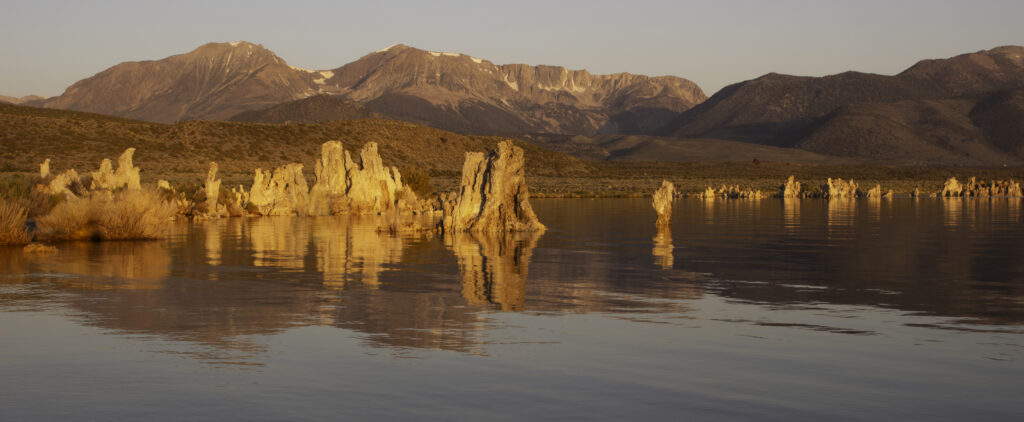






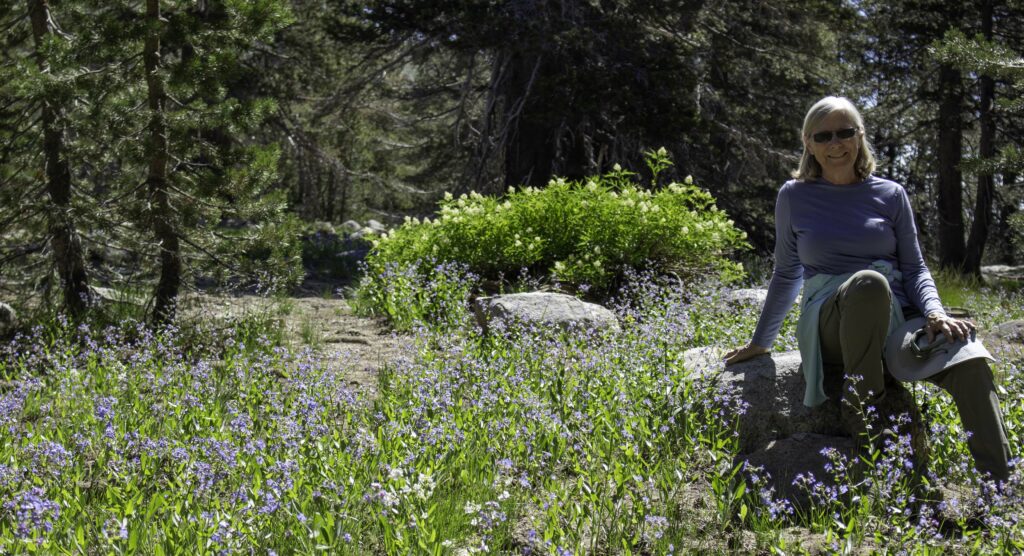


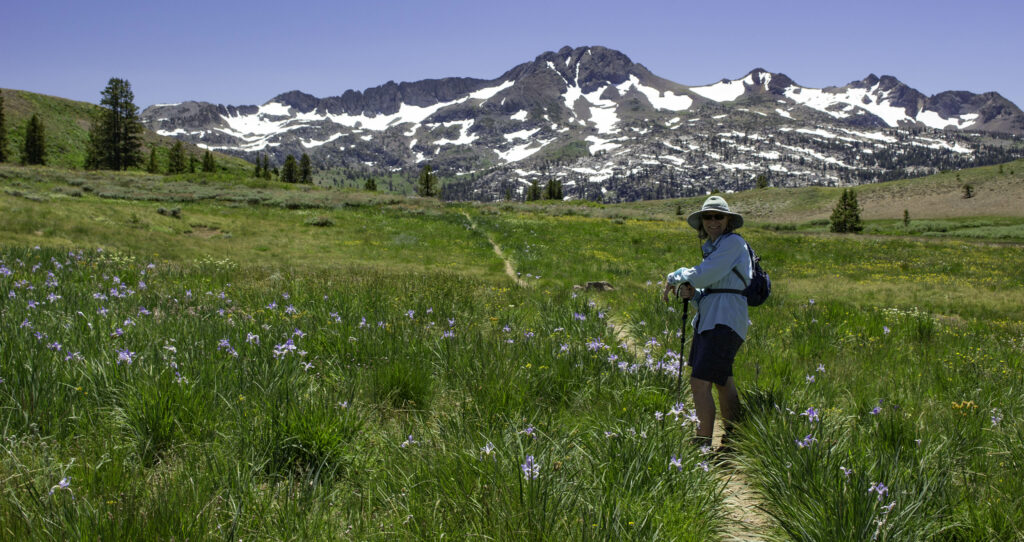




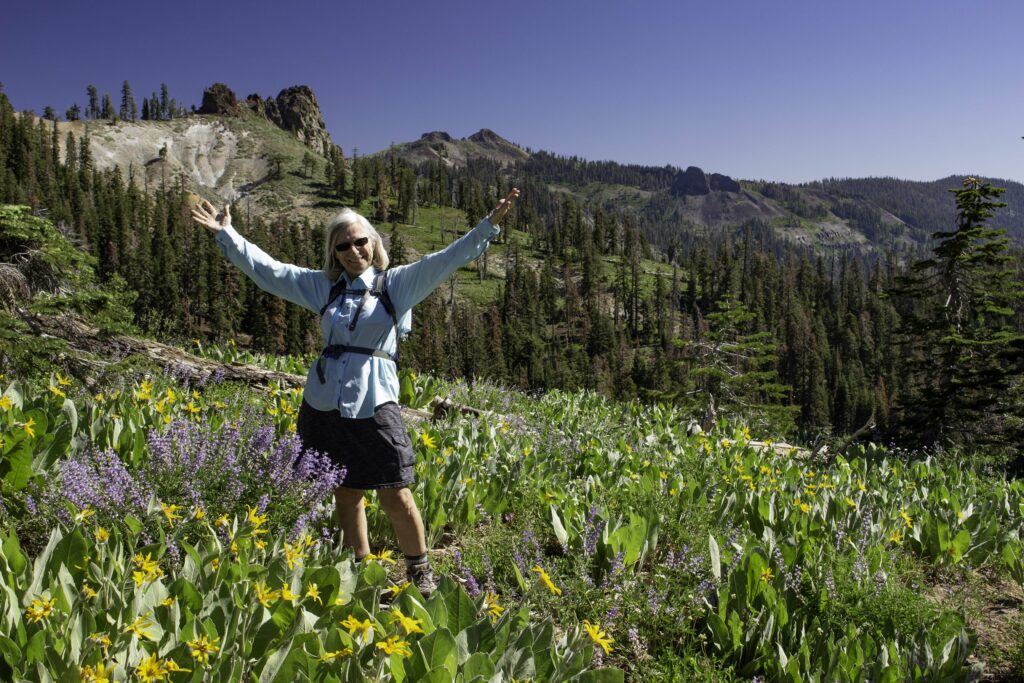


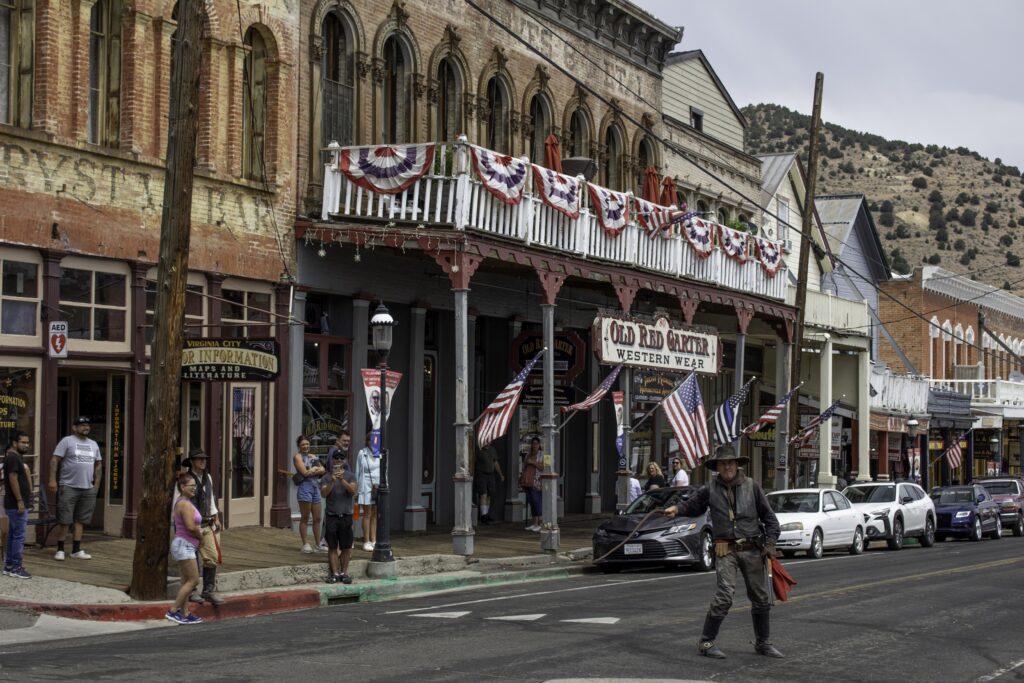




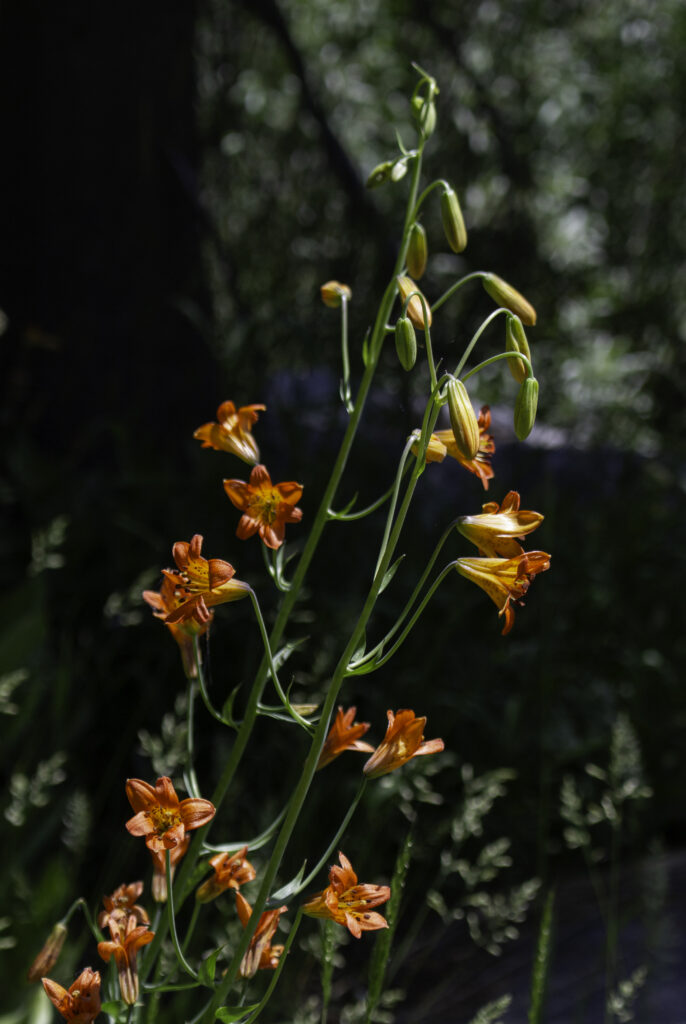
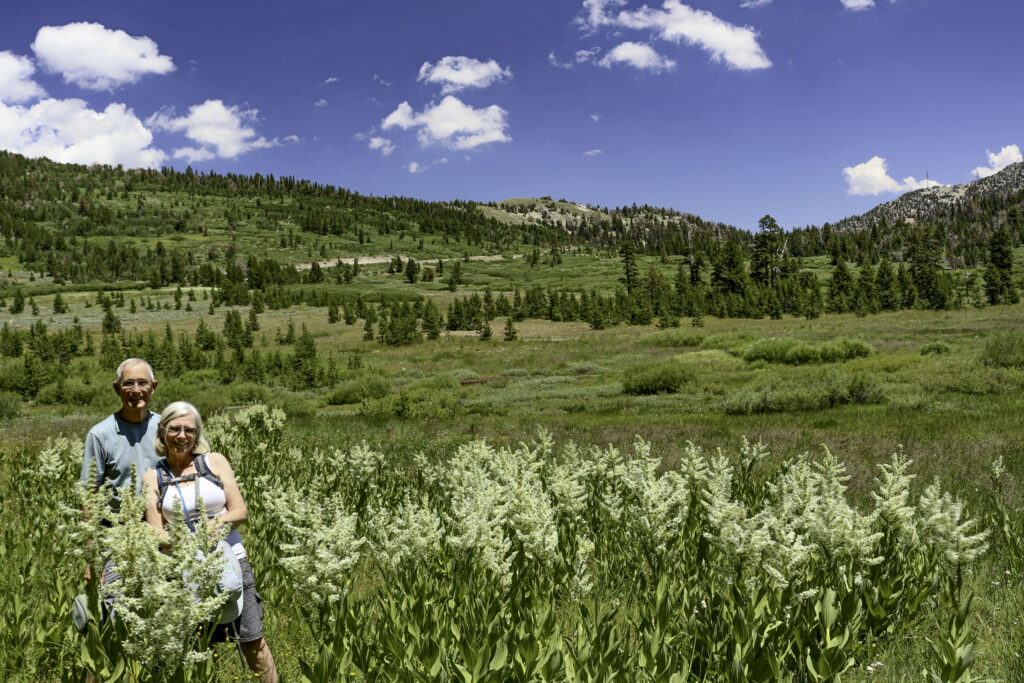
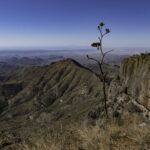
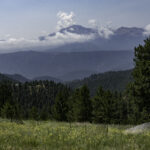
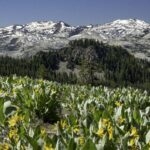
Leave a Reply